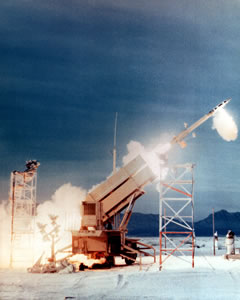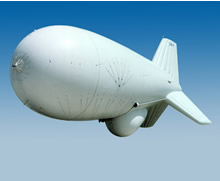
Lockheed Martin’s PAC-3 Missile successfully intercepted and destroyed a cruise missile target yesterday at the Utah Test and Training Range, in an unprecedented interoperability demonstration utilizing the Joint Land Attack Cruise Missile Defense Elevated Netted Sensor (JLENS) and the PATRIOT system.
The test demonstrated a new capability recently introduced with the PAC-3 Missile Segment’s unique ability to detect, track, engage and destroy a cruise missile target at extended range in an integrated air and missile defense architecture that joins netted sensors and missile defense systems to provide greater capability for the warfighter.
PAC-3 has already demonstrated the ability to defeat cruise missile in 2004, as a single Lockheed Martin PAC-3 Missile was fired at a low-flying MQM-107D cruise missile target. The main challenge in defeating the cruise missile target is the detection and tracking of such low-flying targets. Back then the PAC-3 relied on ground-based sensors to spot the targets. However, often in realistic scenarios, an intercept of a cruise missile under these conditions would be considered merely as a ‘lucky shot’. JLENS turns the table in favor of the defender.

the JLENS system developed by Raytheon, referred to as an orbit, consists of two tethered 74-meter aerostats. One aerostat elevates a surveillance radar to 10,000 feet, providing 360-degree coverage out for hundreds of miles over land and sea. The other aerostat elevates a fire-control radar. Each of the aerostat platforms has the capability to integrate other communications and sensor systems. JLENS is designed primarily to detect and track hostile cruise missiles; however, it is also capable of detecting and tracking low-flying aircraft and unmanned aerial systems. JLENS also incorporates the capability to detect and track ballistic missiles, large caliber rockets and surface targets on land and sea.
JLENS provides a ‘look down’ sensor that can better monitor large areas, even over contoured or mountainous terrain, providing the PAC-3 with the data for reliable target acquisition. The system completed the first demonstration test (DT1) in February, successfully proving its ability to track targets and integrate with fire control and tactical data link systems. At the time, Mark Rose, program director for JLENS with Raytheon Integrated Defense Systems explained: “In addition to detecting and tracking targets, the system demonstrated its ability to communicate targeting data over command and control systems, such as Link-16, and interface with combat identification support systems, such as IFF (Identify Friend or Foe), to discriminate between friendly and hostile aircraft and missiles.” these capabilities were essential to the success of the recent intercept.
“The PAC-3 Missile continues to be successful against today’s modern threats, and is ready for tomorrow’s modern plug-and-fight air and missile defense architectures,” said Richard McDaniel, vice president of PAC-3 programs at Lockheed Martin’s Missiles and Fire Control business. “This effort moves us closer towards achieving the U.S. Army’s vision of a truly integrated Air and Missile Defense System.”

















